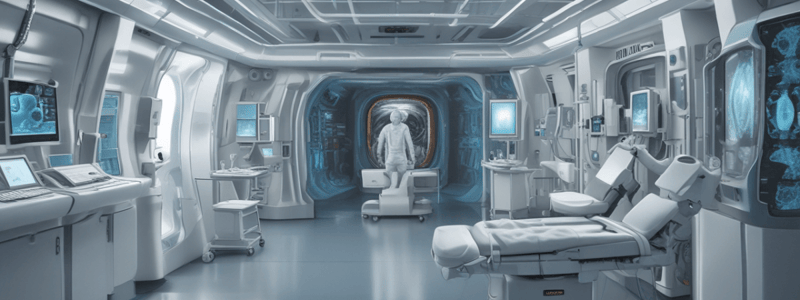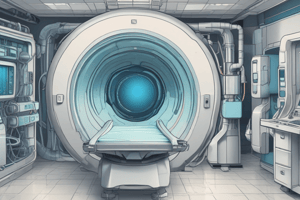Podcast
Questions and Answers
What is the primary difference between EBCT and traditional CT scanners?
What is the primary difference between EBCT and traditional CT scanners?
- The use of a spiral scanning pattern
- The use of multiple X-ray tubes
- The use of a rotating detector array
- The use of a stationary tungsten ring (correct)
What is the advantage of increasing the number of detector rows in CT scanners?
What is the advantage of increasing the number of detector rows in CT scanners?
- Reduced radiation dose
- Improved image resolution
- Ability to acquire multiple channels of data simultaneously (correct)
- Increased scan time
What is a key determinant of image quality in CT scans?
What is a key determinant of image quality in CT scans?
- The focal spot of the X-ray tube (correct)
- The number of detector rows
- The size of the X-ray tube
- The type of X-ray detector used
What is a common artifact that can occur in CT scans?
What is a common artifact that can occur in CT scans?
Why is knowledge of CT artifacts important?
Why is knowledge of CT artifacts important?
What type of artifact is caused by the X-ray beam passing through dense tissues?
What type of artifact is caused by the X-ray beam passing through dense tissues?
What is the benefit of using a dual-source CT scanner?
What is the benefit of using a dual-source CT scanner?
What is the effect of increasing slice thickness in CT scans?
What is the effect of increasing slice thickness in CT scans?
What type of artifact is caused by data inconsistencies between adjacent slices?
What type of artifact is caused by data inconsistencies between adjacent slices?
What is the name of the artifact caused by incomplete data sampling?
What is the name of the artifact caused by incomplete data sampling?
Flashcards are hidden until you start studying
Study Notes
CT Scanner Generations
- First Generation: Single pencil-like x-ray beam, tube rotates around the patient, long scan duration (25-30 mins).
- Second Generation: Multiple beams (up to 30), fan-shaped x-ray beam, translate-rotate movements, average scan duration under 90 seconds.
- Third Generation: Numerous detectors (originally 288, now over 700), fan-shaped beam, rotate-rotate movements, significantly faster scans (around 5 seconds).
- Fourth Generation: Over 2000 fixed detectors in an outer ring, rotate-fixed movements, very quick scans taking just a few seconds.
Sequential and Spiral CT Scanning
- Sequential Scanning: Uses a stop-and-shoot principle where the table is stationary during slice acquisition, resulting in longer scan times.
- Spiral CT: Allows for continuous rotation of the tube-detector system, enabling quicker data acquisition and improved imaging speed.
Artefacts in CT Imaging
- Definition: Artefacts are discrepancies between expected and actual CT numbers in images, measured in HU units.
- Common Artefacts: Beam hardening, Partial Volume Effect (PVE), detector issues, metal interference, and patient motion.
Detailed Artefact Types
- Beam Hardening: Results from low-energy x-rays being absorbed by dense structures, causing misinterpretation of attenuation values. Can be mitigated by pre-hardening the beam or using compensatory algorithms.
- Partial Volume Effect: Occurs when a pixel encompasses multiple tissue types, blurring distinctions—higher resolution or patient repositioning may help.
- Ring Artefacts: Arise from uncalibrated or misaligned detectors; these can distort the image significantly.
- Metal Artefacts: Streaking effects caused by metallic materials obstructing x-ray projection data, removable where possible.
- Patient Motion: Motion blur caused by patient movement during scanning; mitigated by shorter scan times or asking patients to hold their breath.
Image Quality Factors
- Impact of Detector Size: Image quality is determined by detector size, angular projections, and focal spot size.
- Radiation Dose Considerations: Higher slice thickness can lower radiation dose but may compromise axial resolution.
Importance of Understanding Artefacts
- Misinterpretation of CT artefacts can mimic pathological conditions or result in poor diagnostic quality; thus, recognizing the cause is essential.
- Classifications include patient-related artefacts (motion, transient events), physics-related artefacts (beam hardening, noise), and hardware-related artefacts (ring effects, field issues).
Emerging Technologies
- Electron Beam CT: Specialized for cardiac imaging utilizing stationary tungsten rings and electron beams instead of rotating tubes.
- Dual-Source CT: Features two x-ray tubes at right angles, enhancing image quality and precision in imaging.
Summary of Key Principles
- Knowledge of CT scanning principles, including artefact management, is vital for accurate imaging and diagnosis.
Studying That Suits You
Use AI to generate personalized quizzes and flashcards to suit your learning preferences.




